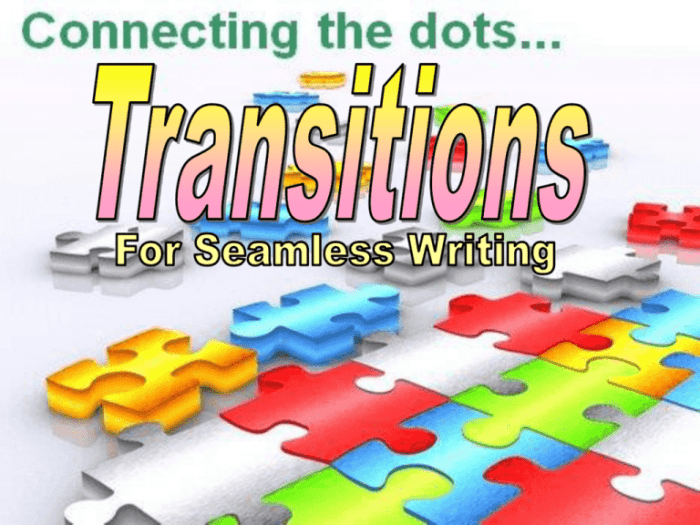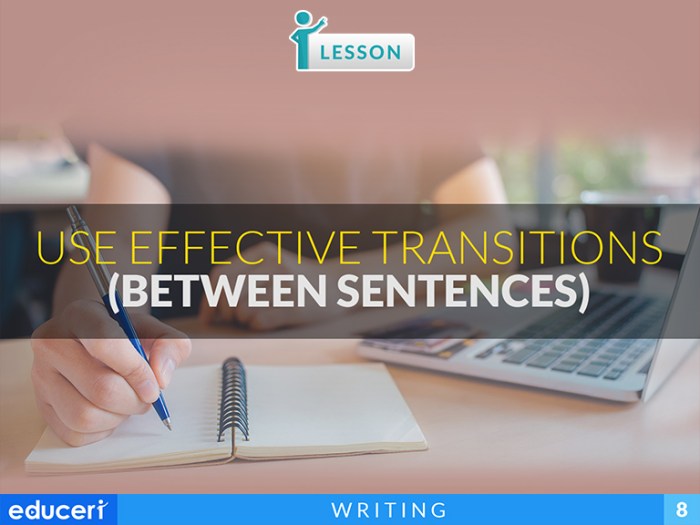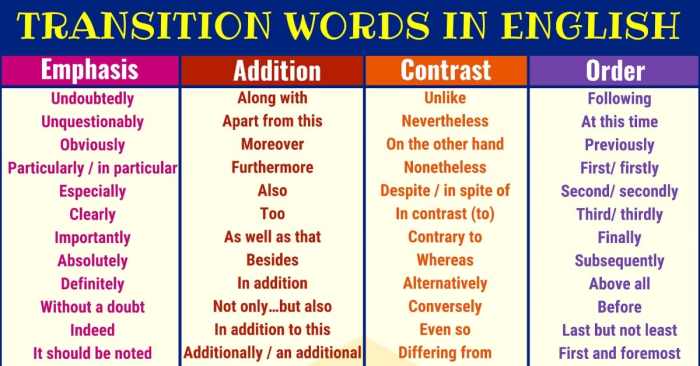Effective transitions move listeners from one topic to another seamlessly, enhancing coherence, cohesion, and engagement. By employing various transition strategies, speakers and writers can guide their audience through complex ideas and maintain a clear flow of information.
Understanding the types of transitions and their appropriate usage empowers communicators to create smooth and impactful presentations or written pieces. This guide explores the art of effective transitions, providing practical tips and insights to elevate your communication skills.
Transition Strategies

Effective transition strategies are crucial for maintaining coherence and cohesion in speech or writing. They facilitate smooth movement from one topic to another, ensuring a logical flow of information and enhancing the overall clarity of the message.
The purpose of transitions is to guide listeners or readers through a sequence of ideas, helping them make connections and understand the relationship between different topics. By using appropriate transitions, speakers and writers can create a sense of progression and prevent abrupt shifts that can confuse or disengage the audience.
Types of Transitions
- Sequential transitionsindicate a chronological order or sequence of events. Examples: first, second, next, finally.
- Spatial transitionsdescribe physical relationships or movement. Examples: above, below, left, right, near, far.
- Comparative transitionscompare or contrast different ideas. Examples: similarly, in contrast, on the other hand.
- Causal transitionsestablish cause-and-effect relationships. Examples: because, therefore, consequently.
- Logical transitionsindicate logical connections between ideas. Examples: hence, thus, accordingly.
Planning and Preparation

Effective transitions require careful planning and preparation. Before delivering a speech or writing a piece, it is essential to organize the content and identify logical connections between topics.
One technique is to create an Artikel that maps out the main ideas and their relationships. This helps to ensure a coherent flow of information and identify points where transitions are needed.
Visual and Nonverbal Cues

In addition to verbal transitions, visual and nonverbal cues can also enhance transitions. Gestures, eye contact, and body language can signal a change in topic and help listeners or readers follow the flow of information.
For example, a speaker might pause slightly, make eye contact with the audience, and use a gesture to indicate a shift in topic. Visual aids, such as slides or diagrams, can also provide visual cues and facilitate smooth transitions.
Practice and Feedback

Practice and feedback are essential for developing effective transitions. Rehearsing a speech or writing multiple times allows speakers and writers to identify and refine their transitions, ensuring they are clear, concise, and appropriate.
Seeking feedback from others can provide valuable insights into the effectiveness of transitions. Feedback can help identify areas where transitions are confusing or unclear, allowing for improvements to be made.
FAQ Explained: Effective Transitions Move Listeners From
What is the purpose of using transitions?
Transitions help connect ideas, guide the audience’s understanding, and maintain a logical flow of information.
How can I identify appropriate transitions?
Consider the relationship between topics and choose transitions that reflect the intended connection, such as addition, contrast, or conclusion.
What are some tips for practicing effective transitions?
Rehearse your speech or writing, paying attention to the flow and coherence. Seek feedback from others to identify areas for improvement.